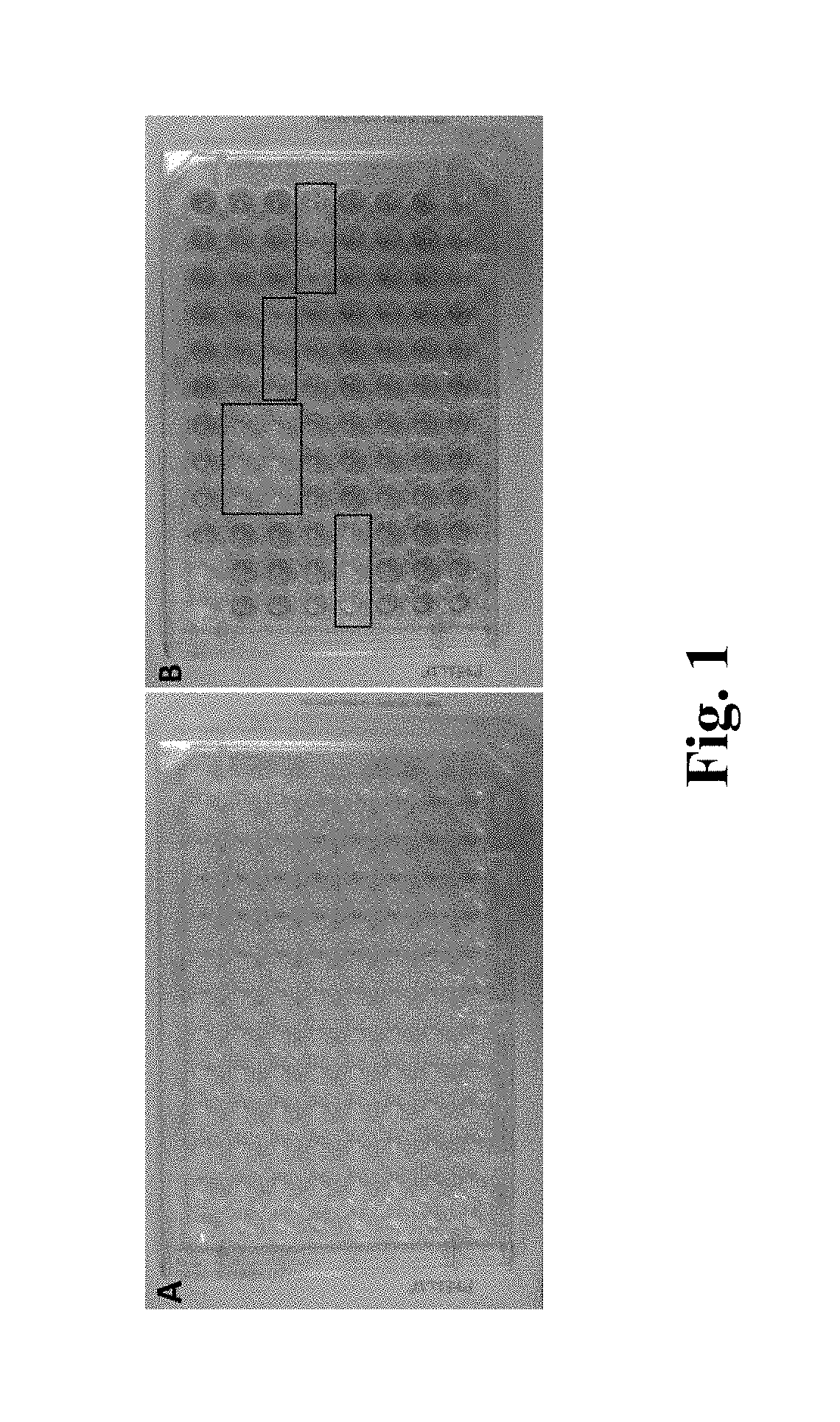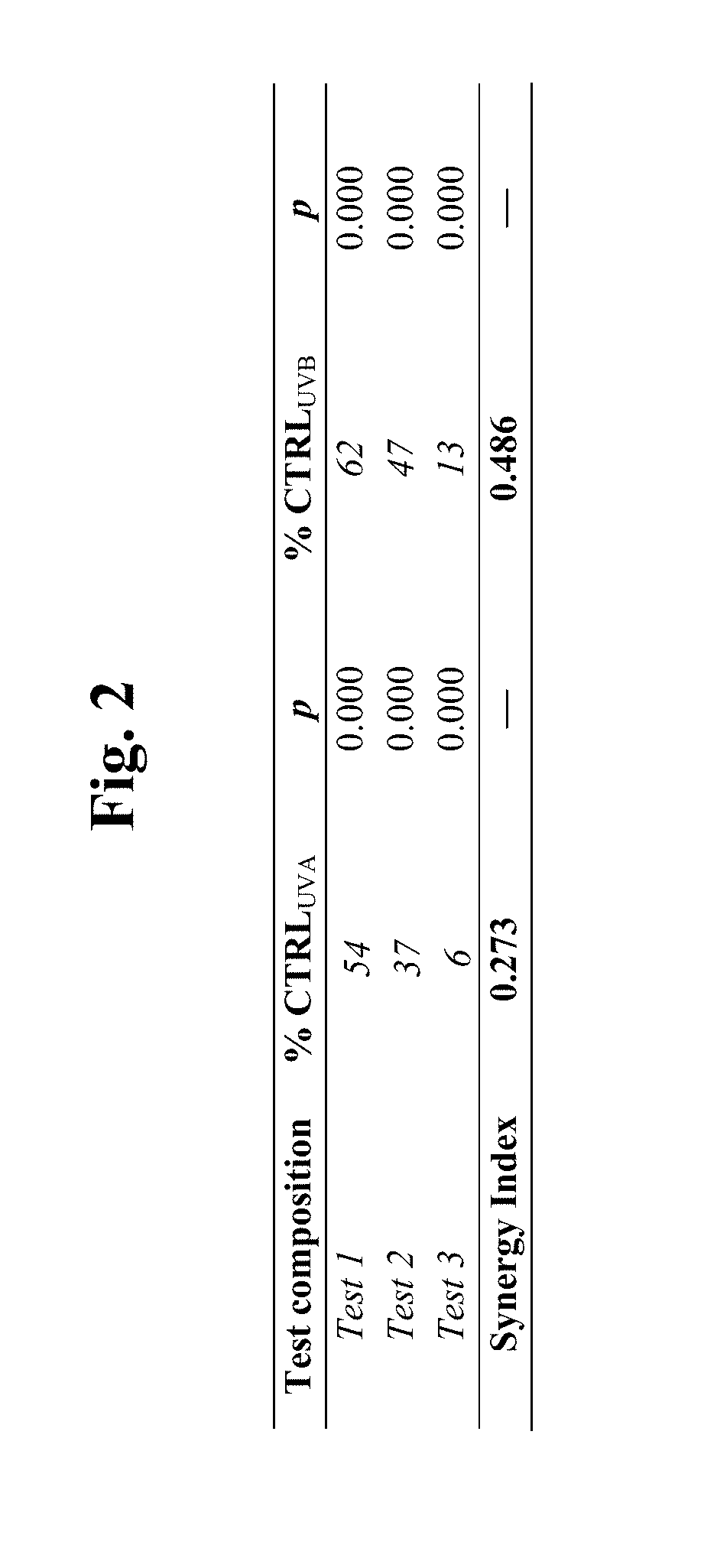Synergistic Compositions That Reduce UV-Induced Lipid Peroxidation, Formulations and Related Methods
- Summary
- Abstract
- Description
- Claims
- Application Information
AI Technical Summary
Benefits of technology
Problems solved by technology
Method used
Image
Examples
example 1
[0057]Test composition 1 was prepared to contain caprylohydroxamic acid (0.15% w / w) diluted in dimethyl isosorbide (0.4% w / w) and water (qsp 100% w / w). Test composition 2 contained ascorbic acid (0.5% w / w) diluted in the same solvent as test composition 1. Finally, test composition 3 was prepared containing both caprylohydroxamic acid (0.15% w / w) and ascorbic acid (0.5% w / w) diluted as test compositions 1 and 2.
[0058]UV-induced lipid peroxidation was evaluated for each of the test compositions 1-3, using the method develop by Pelle et al. from Estee Lauder (Pelle, E., D., Maes, G. A. Padulo, E. K. Kim and W. P. Smith, “An in vitro model to test relative antioxidant potential: ultraviolet-induced lipid peroxidation in liposomes”, Arch. Biochem. Biophys., 283, pp. 234-240 (1990)) as modified by Wang et al. (Wang, Y. R., H. Zhao, X. S. Sheng, P. E. Gambino, B. Costello and Bojanowski K., “Protective effect of Fructus lycii Polysaccharides against time- and hyperthermia-induced damage i...
example 2
[0062]In this example, test composition 4 was prepared to contain caprylohydroxamic acid (0.15% w / w) diluted in dimethyl isosorbide (0.4% w / w) and water (qsp 100% w / w). Test composition 5 contained a pool of antioxidants (1.8% w / w), which comprised ascorbic acid (0.4% w / w); sodium ascorbyl phosphate (0.4% w / w); α-tocopherol (0.4% w / w); tocopheryl acetate (0.4% w / w) and butylated hydroxytoluene (0.2% w / w) diluted in a mixture of dimethyl isosorbide (0.4% w / w), polysorbate-60 (0.3% w / w) and water (qsp 100% w / w). Finally, test composition 6 was prepared to contain both caprylohydroxamic acid (0.15% w / w) and the pool of antioxidants (1.8% w / w) diluted as test composition 2 was.
[0063]Evaluation of lipid peroxidation was carried out as in Example 1. Using the data generated, the synergy index for test composition 6 was calculated using the Kull equation. FIG. 3 presents the synergy index results for UV-induced lipid peroxidation.
example 3
[0064]A test composition 7 is prepared to contain caprylohydroxamic acid (0.15% w / w) diluted in dimethyl isosorbide (qsp 100% w / w). A test composition 8 is prepared to contain a combination of beta-carotene (0.5% w / w) and carrot oil (0.5% w / w) diluted in the same solvent as test composition 7. Finally, a test composition 9 is prepared to contain both caprylohydroxamic acid (0.15% w / w) and the combination of beta-carotene and carrot oil (0.5% w / w, respectively), diluted as test composition 7 is.
[0065]Evaluation of lipid peroxidation is carried out as in Example 1. Using the data generated, the synergy index for test composition 9 is calculated using the Kull equation. FIG. 4 presents the synergy index results for UV-induced lipid peroxidation.
PUM
| Property | Measurement | Unit |
|---|---|---|
| Time | aaaaa | aaaaa |
| Time | aaaaa | aaaaa |
| Time | aaaaa | aaaaa |
Abstract
Description
Claims
Application Information
 Login to View More
Login to View More - R&D
- Intellectual Property
- Life Sciences
- Materials
- Tech Scout
- Unparalleled Data Quality
- Higher Quality Content
- 60% Fewer Hallucinations
Browse by: Latest US Patents, China's latest patents, Technical Efficacy Thesaurus, Application Domain, Technology Topic, Popular Technical Reports.
© 2025 PatSnap. All rights reserved.Legal|Privacy policy|Modern Slavery Act Transparency Statement|Sitemap|About US| Contact US: help@patsnap.com



